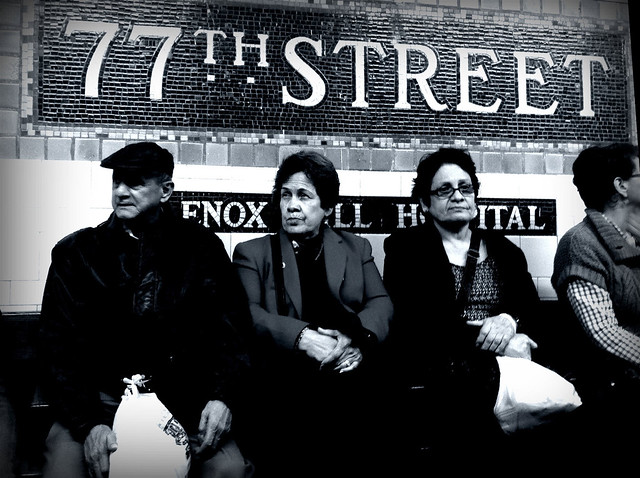For many New Yorkers, the L train has come to symbolize the best and worst of the city in 2013. Derided as the train for hipsters and trustafarians who have overrun Williamsburg, it has also become a test line for the MTA’s technological ventures. Thirty years ago, the MTA nearly considered axing the line, and now it’s often one of the most crowded. Perhaps though it’s time for the MTA to yet again assess service patterns on the L line.
The L, as riders have come to know and hate, is generally never not crowded. During the weekday rush hours, it’s often impossible to find space, let alone a seat, and the weekends are much the same. In fact, according to one study, the weekends may actually be worse because of the MTA’s service patterns. In a piece for the Rudin Center’s website, Carson Qing examined L train ridership at Bedford Ave. and discovered that weekend usage in August essentially mirrored normal weekday loads.
Here’s Carson’s take on the data:
What’s remarkable about this case study for Bedford Avenue is that not only are there ridership peaks for long durations on Saturday (8 am to 4 am Sunday) and Sunday (8 am to 8 pm), but entry/exit figures are actually comparable to morning and evening rush hours during the work week: thus, growth in weekend ridership at Bedford Avenue has increased so much that it may very well have resulted in an “extended rush hour” for almost the entire weekend.
Even more remarkable is that the peak entry hours on Saturday night actually extend into the wee hours of Sunday morning for the sampled data, suggesting that the crowded subway platform at 1:30 AM might in fact be quite a common occurrence. Given recent, dramatic changes in demographics and land use patterns in Williamsburg, these unusual peak hour trip patterns should be expected. Not only has there been a well-documented influx in 25-to-34 year olds in Williamsburg (25% of the population, compared to 17% in 2006, according to census data), but there has also been a significant growth in restaurants and bars that are open late on weekends and draw young New Yorkers from across the city to the neighborhood (117% increase in full service restaurants and 59% increase in bars since 2005, according to census business data). The peak entry hours from 12 am to 4 am on a Sunday morning should be expected given the context of how Williamsburg has changed dramatically in just a few short years, as many of the restaurant and bar patrons are likely contributing to this peak period of subway ridership during these late night hours.
These trends reveal that due to the growth in weekend ridership on the L-train, conventional assumptions of travel demand for this particular subway line may no longer be appropriate, and may require some adjustments in service offerings during weekend evenings, late nights, and other times of day. According to subway schedules, the MTA currently runs roughly 43 Manhattan-bound trains on the L during a weekday morning rush hour (8 am-12 pm) and 48 Manhattan-bound trains during Saturday afternoon (4 pm-8 pm), falling to roughly 32 on Saturday night (8 pm -12 am) and 13 during weekend late-night hours (12am-4 am Sunday). With only 13 trains during one of the busiest travel periods of the entire week, crowded platforms at Bedford Avenue and nearby stations during late Saturday nights/early Sunday mornings will likely be commonplace going forward.
This is but a snapshot of one weekend in Williamsburg, but it should lead to further studies. Ultimately, transit planners have to assess if the L train’s weekend rush hour requires extra service? It’s long been the rule that transit ridership is highest during peak hours surrounding the work week, but the L train — which runs past some popular nightlife areas — has bucked that trend recently. Thirteen trains over a four-hour period may not be enough to meet demand.




 (Overnights)
(Overnights)









 (42nd Street Shuttle)(Overnights)
(42nd Street Shuttle)(Overnights)
 It’s been exactly a month since Joe Lhota stepped down as MTA CEO and Chair to run for mayor, and we’ve heard nothing at all about a potential replacement. Last time around, Gov. Andrew Cuomo announced a search committee, but this time around, as is often the case, Cuomo has seemingly forgotten that the MTA both exists and has two men sharing temporary duties as Chairman and Executive Director.
It’s been exactly a month since Joe Lhota stepped down as MTA CEO and Chair to run for mayor, and we’ve heard nothing at all about a potential replacement. Last time around, Gov. Andrew Cuomo announced a search committee, but this time around, as is often the case, Cuomo has seemingly forgotten that the MTA both exists and has two men sharing temporary duties as Chairman and Executive Director.

